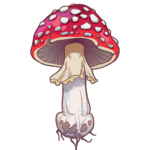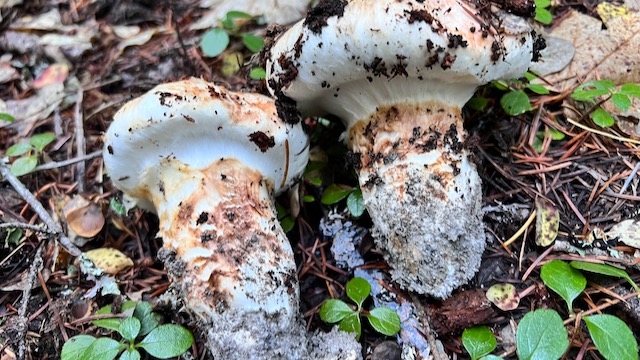
Matsutake mushrooms, highly valued for their unique aroma and culinary applications, can be identified by several key features:
- Cap: The cap of a matsutake mushroom starts white and transitions from a rounded shape to a flatter form as it matures. Fibrils on the surface of the cap are typically flat so the cap will appear mostly smooth.
- Gills: Initially white, the gills change to a reddish-brown hue with age. They are either squarely attached, at a right angle, or notched, but importantly, they do not extend down the
- Veil and Stem: The veil often shows rust-colored stains and leaves tissue flaring upward on the stem. The stem tapers towards the base, which is frequently covered in a chalky soil, and does not flare out into a bulb.
- Flesh: Resistant to crushing, the flesh of the matsutake mushroom is robust, adding to its culinary appeal.
- Scent: A key identifier is its distinctive scent, often described as funky, sweet, and similar to cinnamon candy.
- Taste:
Together, these characteristics are essential for accurately identifying matsutake mushrooms in the wild.
Matsutake is also known by scientific names Tricholoma magnivelare and Tricholoma murrillianum
Similar in Appearance:
Smith’s Amanita
Amanita smithiana
Key features of Amanita smithiana:
1. Veil remnants: Tissue on the surface of the cap is often fluffy and white. This contrasts with the fine fibrils of a matsutake that lay flat against the surface of the cap
2. Easily squished: Squishing the stem of Amanita smithiana between your fingers is quite easy. This contrasts with the very firm stem of matsutake
3. Bulbous base: Amanita smithiana has a flaring or bulbous base of the stem. This is a common attribute of most Amanita mushrooms. The base of Tricholoma murrilianum/ magnivelare is tapered and does not flare out towards the bottom
4. Scent: Amanita mushrooms lack the classic cinnamon scent of matsutake. This characteristic is imperfect for identification because a forager might smell matsutake picked previously, and often smell what we want to.
When gathering matsutake mushrooms, exercise caution to avoid mistaking them for the seriously toxic Amanita smithiana. This mushroom is extremely toxic and commonly grows in the same habitats as matsutake. It’s essential to accurately distinguish between these two types of mushrooms when picking them for eating.
Catathelasma ventricosum
Very similar in appearance but not seriously toxic like Amanita smithiana. The key differentiator is the gill attachment. C ventricosum has decurrent gills that extend down the stem. Matsutake gills attach at a right angle, or a small notch.

